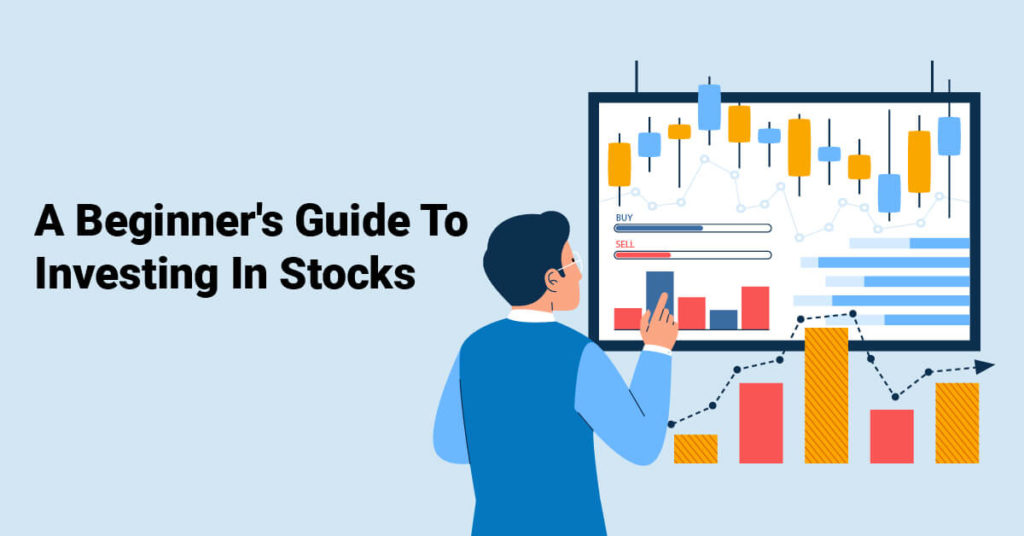Investing is a smart move to increase your financial worth. Generally speaking, the stocks do the work for you, and your money increases without any input from you.
Although this is a basic explanation for investing in stocks, the concept follows true. However, if you want to learn more about stocks and take a serious look at how you can increase your wealth, you need to know about the finer details too.
Today, we will explain exactly what stocks are, how to get started in investing, and show you all the important factors you need to consider first. Once you're serious about investing, you can even start using a tool for part-time investors to help guide you.
Table of Contents
- What Are Stocks?
- Getting Started With Investing In Stocks
- Things You Need To Know About Investing In Stocks
- 1. You Are Taking A Risk With Your Money
- 2. There Are No Guarantees
- 3. You Can Buy And Sell Shares On The Stock Market
- 4. Only You Can Decide If Investing Is For You
- 5. You Should Never Invest More Than You Can Afford To
- 6. A Share Is A Unit Of The Value Of A Company
- 7. A Fund Is Where Investors Put Their Money Together To Invest In Shares
- 8. Research Is Key
- Frequently Asked Questions
- Summary
- If you enjoyed our guide, make sure to read:
What Are Stocks?

Before you get started investing in anything, you need to know the general idea of what “stocks” and “investing” actually are. Without this information, you can easily lose your money through avoidable mistakes.
What Is A Stock?
In literal terms, stocks represent the amount of ownership you have in a corporation. Sometimes stocks are also called “equity” and you may find the term “shares” floating around too.
Shares are a collection or unit of stocks. For example, a company might be selling 0.001% of stocks at one price, and shares representing 0.01% of the company for another.
The owner of the company will have stocks in proportion to how much of the company they own.
Although you can buy and sell stocks on private platforms, you mostly find the exchange on the stock market. The stock market is a protected area that the government regulates. This means that investors are secured against fraud and malpractice.
There are two types of stocks, the preferred and the common.
Preferred stockholders don’t have voting rights. In exchange for this denied interaction, they can have higher claims on the business creating larger dividends. They are often paid before the common stockholders and given priority treatment.
Common stockholders can vote in shareholder meetings, choosing control in the business over higher payments. They will also be lower on the priority list if the company goes into bankruptcy.
What Is An Investment?
An investment can be anything that allows you to generate an income or appreciation for something. In this context, appreciation is when an item or asset increases in value over time.
For example, investing in art may not give you an income straight away. If you decide to sell the art 10 years later, the cultural value could increase, creating a hike in financial value too. That hike is the appreciation.
In general investing is when you put money on something assuming it will grow in wealth in the future. When you invest in stocks, you are hoping the business will grow with your money, making your percentage of worth increase in value despite the percentage not changing.
The company would use your money to increase its ability to raise its revenues. They could do this by expanding their stores, hiring more employees, modernizing their style, or any number of things.
However, just as your money could grow with the investment, the company could make a bad judgment and decrease the value of your investment. For example, they would expand their reach to a new location, but the store doesn’t do well sinking their revenue and worth.
Any type of investment is a risk, which is why you should stick to well-known offers which have strong and stable increases. As you get more confident and knowledgeable, you can branch away from these safer options.
Getting Started With Investing In Stocks

If you invested $10,000 50 years ago, that money could be worth around $1.2 million today.
Although 50 years is a long time, this brief look into the reality of investing should show you just how effective stocks are at increasing your wealth.
1. Determine An Investing Approach
Before you can decide which approach you want to take, you need to take a realistic look at yourself. Anyone can be a stock investor, but some paths are easier depending on your personality type.
We like to separate everyone into three types of investors: the researchers, the worriers, and the unavailable.
Ask yourself if you like looking into the details of a situation, and solving math puzzles is fun. If that's the case, we consider you a researcher.
If you like the idea of mild reading about the company but want to make the risks as low as possible, then we consider you a worrier. And lastly, if you don’t have the time to look into the business and want someone else to do the investments for you, then we class you as unavailable.
Knowing these personality types, we can tell you which investing approach would benefit you most.
Individual Stocks
Individual stocks are the best option for the researchers among you. You need to dedicate time to research the stocks thoroughly and evaluate each company constantly.
This means learning about the background of the company, the changing business environment, seeing how the math interacts with this business, and so on. It might seem like a lot, but once you learn the in’s and out’s you’ll see that it’s all about maintaining your knowledge.
This method is for patient investors who know what they are doing and understand when to back out of an investment. For most first-time investors, this method should not be your choice. But once you learn more about the stock market and become confident in your knowledge, you can swap to this approach for larger financial rewards.
Index Funds
Index funds are the choice we would suggest for the worriers. They are often suggested for holding retirement accounts as there is a low risk and low turnover opportunity. Generally speaking, index funds are used to mimic the performance of the financial market as a whole. You don’t need to do a lot of research when you start investing in them as they are low risk.
You can also ask a financial advisor to walk you through the index fund to minimize your involvement even further. Either way, you will receive the payments passively and you don’t need to monitor the stock market to make sure your investment is still positive.
Robo Advisors
As the name suggests robo advisors are automated investment platforms, which are perfect for people with no time to research investment opportunities. The unavailable person we described before doesn’t have to spend time reading through investment strategies, as the robo advisor in these platforms does all the work for you.
Normally this option is offered to Generation X, Y and Millennials as you need to be comfortable with technology to use the system, but they are made to be simple so those without financial backgrounds can understand them.
The system will automatically make trading decisions to the best value with the lowest risk. As human judgment is taken out of the equation, there is no room for “tempting but dangerous” investments, as the robotic system will eliminate any options that are too risky. Your dividends will be low, but they will be safe.
2. Decide How Much You Will Invest
As a rule of thumb, you shouldn’t invest whatever you might need in the next 5 years. Ideally, that means giving yourself a 5-year buffer of minimum pay. Some suggest having just a 3-month buffer, but in recent years we now realize that losing your job during a pandemic doesn’t mean you can find another in under 3 months.
You need a buffer to protect yourself against unexpected circumstances, that way when money becomes tight you have a pocket of wealth to protect you until you find your feet again.
However, if you have over 5 years of monthly pay patiently waiting for an emergency to arrive, then you can invest the remaining wealth. This concept is called Asset Allocation.
Now you know what you shouldn’t invest with, it’s time to see how much you should invest. Take 110 and subtract your age. This is the rough percentage of your remaining wealth that you should invest with.
For example, if you are 30 years old, and after the 5-year buffer, you have around $5,000 left. You should invest 80% of $5,000 which is $4,000.
This is just a guide though, you may decide to invest the whole $5,000 knowing that your income and 5-year buffer has been removed from this figure. Or you might think the investments are too risky and prefer to invest just $1,000 instead.
3. Open An Investment Account

When you know which type of investment you want to begin with, and are aware of how much money you are happy using, you need to learn how to actually buy the stocks.
First, you need to open a brokerage account. These can be opened in license brokerage firms. These firms can help you manage the taxable element of capital gains.
Opening up these accounts is easy, however, you need to decide which type of account you want to choose from. For beginners, we normally suggest either a standard brokerage account or an IRA (Individual Retirement Account).
Your location will also play a role in which stock broker you choose. Some trading platforms and online brokers are better for Europeans, while others might cater more to clients in Asia like stock trading platforms in Singapore.
Both are designed to let you buy stocks (among other things), but the difference is around interest and the ability to withdraw.
IRAs are hard to access, as they are designed to be released after retirement. This allows them to grow with ease creating a bigger pot of money when you need it most.
If you want to access your investment income whenever you want, then you should choose a standard brokerage account. These allow you to withdraw money a lot quicker, but the interest rate will be lower to allow for this privilege.
Ideally, you should pick a good broker which also offers educational tools to help you understand investments. They might even show you good investments through their memberships. This creates a semi robo advisor as the bot isn’t investing in the stocks for you, but shows you what is available.
4. Choose Stocks
When you choose the stocks you wish to invest with, be sure to keep the following advice in mind:
Keep Your Investments Diverse
Although brokers can offer you low-risk options, you will never be free of risks completely. To make sure your stocks don’t all crash for the same reason, you should diversify your portfolio. That means putting your investment in different areas, to make sure that one unexpected drop in the market doesn’t destroy all of your investments.
Invest In What You Know
Ideally, you should only invest in what you know. We expect new investors to be amateurs when it comes to investing, meaning they already have a learning curve to understand. To make your life easier you shouldn’t make the business a learning curve too. Pick something you already know well, so you can understand when something is going well or not.
For example, if you work in the building industry and can see that the company is opting for cheaper materials, then you may want to pull out of the investment knowing the company is risking lowering its standards.
Avoid Dramatic Stocks
Until you understand how the stock market works, you should avoid any markets that jump dramatically between profit and loss. You should start off with a business that is slowly growing, so you can understand their predictions.
Learn To Evaluate The Stock Market
To really get the best out of the stock market, you should learn the system. That doesn’t mean you have to get a degree in finance, but you should pick up a book or two around the subject and learn to pick up the quirks and rules as you go.
5. Keep Investing
The best way to reach top earnings when investing is to keep going. Using elements of your dividends to put into more shares and stocks will make it extremely easy to increase your wealth.
The more you invest, the easier it will be for you to see when a company is failing and you need to pull out. It will also help you notice the rise in gains that others are seeing, encouraging you to put your money in too.
Although stocks are often the cheapest option, you should aim for shares when you can. Granted you won’t have the same power as a stockholder, however, you will have better financial security and more money coming in.
However, the more you invest, the more volatility you will experience. This means you will lose as well as gain money on this journey. Don’t let that knowledge put you off though, as your ability to see the trends as you increase this experience should protect you from massive falls.
Things You Need To Know About Investing In Stocks

Before you rush to the bank and open up a new account, there are some things you need to know. As we said before, there is a risk of losing money, but the negatives go deeper than that.
To make sure you are completely equipped with the information you need to make smart and healthy financial decisions, please note these 8 important facts.
1. You Are Taking A Risk With Your Money
Investing might feel like putting your money away into a savings account, but with bigger rewards, however this is far from the truth. When you invest you are putting your money into the hands of another business and hoping that they will produce more of it because of your help.
Nothing is guaranteed in this agreement, meaning you can lose your money if the business fails.
This is why you should take every investment seriously, and understand what the business is offering and how they function. Knowing the business you are investing in can help you figure out if their intentions and predictions are realistic or just a daydream.
2. There Are No Guarantees
There are no guarantees in investing. A company may be able to give you a prediction that can be backed up using mathematical equations, historical data, and outside sources, but all of that is an estimate.
Investments with smaller returns are often less dramatic in their plans. This means there are fewer variables, so the likelihood of their estimates being wrong is low. A low return rate is a safe option, which is why we keep suggesting it in this article.
You may notice that a bunch of stock options are using the same data for their estimates. When you see this, be sure to avoid investing too much in this network. If you did invest in a lot of these companies and then found that their estimations were incorrect, all of the businesses will lose money.
When we say to diversify your portfolio, looking at the estimates and their data can be one way to be sure that your investments are distant from each other.
Yes, you can buy your shares on the stock market, but you can sell them there too. Just because you invest in something doesn’t mean that you are bound to it forever.
The shares exist to give more money to businesses and reward those who have helped. However even if a company is making money, it will not be constantly rising all the time.
The value of their shares will rise and fall depending on their economic value, the ability to buy more of the stock, and the perceived value.
For example, if there are no more stocks available to buy, everyone’s shares will increase in value due to demand. This could be a prime time to sell your stock.
On the flip side, if a niche market suddenly receives an influx of more business, the niche companies are worth less as competition grows. Due to this interaction, the value of the shares will decrease until the business can prove they are doing better than the new influx.
4. Only You Can Decide If Investing Is For You
No matter if you are a first-time investor or an old hand, only you can decide if the “risk versus reward” is worth investing in.
Throughout the history of stock markets, the increase in revenue from stocks in comparison to savings accounts has been substantially higher. They have outperformed the safest option without a doubt. However, that is an overall average and not an everyday interaction.
The best way to keep out of the red and into the black is to research the offers available to you. You should also keep an eye on your finances and be realistic about your needs.
If your financial situation changes and you need to back out of your investments, then take that decision seriously, as losing gains to keep yourself stable is more important than waiting for a big payout.
This might sound like basic advice, but in reality, it can be easy to get pulled into the world of financial gains and lose control over your ability to back out. This is only a mental issue, of course.
Like gambling, there can be personality types that need an extra hand. Touching base on your realistic financial situation can help ground you in reality and help you understand what you actually need.
5. You Should Never Invest More Than You Can Afford To
We have already said before that you should have 5 years' worth of your salary saved before getting into investing. However, some people might think that this rule is too strict. If you are thinking the same thing, then at least only invest what you can afford to lose.
Remember that although you are likely to get a return, it cannot be guaranteed. To make sure any losses don’t put you into financial difficulties, you should only be investing with money that you can lose.
For example, you could invest with as little as $10. If $10 is considered unremarkable to you, and if you were to spend it without thought anyway, then investing $10 is a great idea.
However, you shouldn’t put $500 into an investment, if without it you cannot pay rent. Again this might seem like basic advice, but in reality, many people forget that investing doesn’t always come back with gains. You need to be reminded that losses are possible, and act responsibly with your money.
Many beginning investors decide to only invest with a certain amount of money per month but use the gains from that investment to earn more money if they can.
For example, they could put $50 aside every month for investment, but if one comes back with a $500 return, they may choose to use that $500 to reinvest; thereby putting more money into their portfolio without taking extra funds from their accounts.
As we have said before, a share is a unit for the company's value. This means that as the company increases in worth as do your shares. Investing in a company while it is worth low, and then watching it boom into financial success, means that your small $1 investment might grow to $200.
This is why we keep saying to invest in areas that you know well. For example, if you see a business being developed in your area, and they have targeted a demographic that you know will hit it off, then investing in that company is a researched and confident choice.
It will have cheap investment opportunities due to the newness of the company, and if you are correct, it may jump up the market as more people become aware of it.
If you want to make risky investments such as new business, be sure to invest in small amounts to account for any failures.
You may notice the term “fund” being used. This is simply another method to buy shares. Funds are when you group up with other people to invest in a share.
These options are more common in big businesses that create strong and stable investments, in turn producing big returns. As the returns are high, the shares can be expensive.
The shares in the fund get broken up into units. For example, if the fund is worth $1,250, it might be broken up into 500 units, meaning that 500 people have to pay $2.50 to invest.
Finding these large groups of people is usually orchestrated by robo-advisors or large investment companies. Either way, you are not required to find 500 people to invest with you. However, with these strangers' help, you can enter into large shareholding spaces which will look great on your portfolio.
Although we are primarily talking about the stock market, it is worth noting that you can get funds in almost anything. You can fund countries, oil, other people’s debt, and even gold.
Funding debts means buying the debt off of a bank or building society, and asking the debtor to pay you back instead. They pay you back with interest.
8. Research Is Key
Lastly, to get the most out of your investment and money, you should research the businesses. There are options for you to invest without putting the time or knowledge into your choices, but the best investments for the greatest gains are found through studying.
Learn the terms that you see on your investment sights, watch how the stock market is growing and shrinking, and see how each business is doing in its sector.
This knowledge will soon become natural to you, but understanding it is the difference between small gains and big ones.
Frequently Asked Questions

Have more questions? Let's dive into them. Here is a list of frequently asked questions, that might hold the answers you need.
Where Do I Start If I Want To Invest In Stocks?
If you need something more specific than what we have above, then you should invest in online opportunities. These will be easy to manage, easy to understand, and cheaper than other investments. You will need a brokerage account to do this, but online opportunities will give you more availability.
How Can I Invest $1,000?
The first option most people go with is putting their $1,000 into a savings account. However, if you already have one and we're hoping for an investment that brings larger returns, then you should consider a taxable brokerage account, IRA, or robo-advisor.
The robo-advisor is the least complicated and is done automatically, meaning you don’t need to learn the tricks of the trade, however, the returns will be low risk with low rewards.
IRAs give bigger rewards but you cannot access them until you retire. And brokerage accounts give you more freedom, the ability to withdraw your fund, and higher rewards, but they also come with higher risks.
Is It A Good Time To Start Investing?
Yes. Investing is less about the economic circumstances of the time and more about the long-term commitment you plan to make. You also need to consider what you are investing in. If you are worried about the struggling economy, then choose a business that isn't hindered by the debts around it.
For example, during the Covid pandemic, many restaurants couldn’t cope with the lack of customers. During this time it would have been ill-advised to invest in restaurants due to their rocky situation. However, online businesses began to boom, investing in them would have been a safe option during this unprecedented time.
Summary

Although investing in stock can be a great way to boost your income and increase the diversity of your portfolio, it is a risk just like any other investment.
However there are high-risk and low-risk options for you to take part in, and unlike other investment opportunities you can put down a small amount of money to obtain the deal.
Although it would be best if you researched the businesses you hope to invest in, it isn’t necessary if you choose options such as robo-advisors. However, the best way to make sure your money is safe is to pick an opportunity that fits into an area that you know well.




